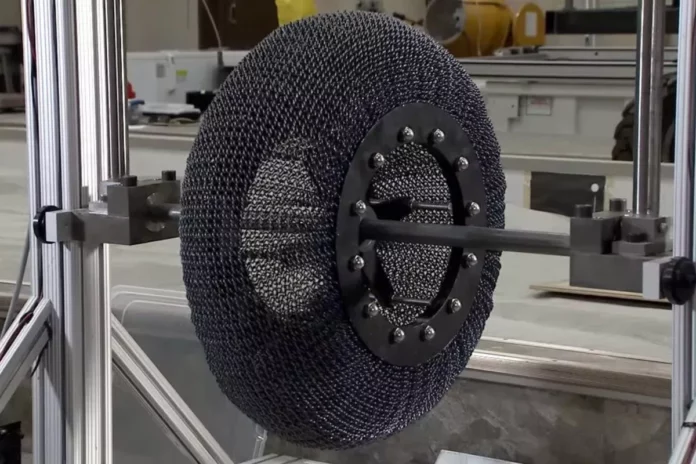While millions of Americans tuned in to watch NASA perform another successful rover landing on Mars this past February, a new startup was preparing to announce Earthly intentions for a core technology behind the future of space exploration. Starting next year with the METL™ tire, The SMART Tire Company intends to take on the $250B global tire industry and bring an end to the era of flat tires, and reduce rubber waste, using space-age tire technology first designed for heavy vehicles on Mars. [Source: Good.is]
“After completing and winning a NASA Startup Studio program in 2020, my Co-Founder (Brian Yennie) and I formed a new company, The SMART Tire Company, to license NASA’s superelastic tire patents and continue our work with NASA through a Space Act Agreement and commercialize the technology for consumer use. Since the beginning of this project, we’ve been asked many times about ‘Reinventing the Wheel’, and we like to say that actually, we aren’t. Our tires will still be round and get you from Point A to Point B. What we are doing is re-imagining the wheel and what our expectations are for such an important part of everyday life. Does it make sense that Americans deal with hundreds of millions of flat tires every year, or that 50 billion pounds of tire waste and microplastics pollute our environment annually? Is there no better way? We’re going to still need round wheels to get us around for a long time, but it doesn’t need to be this dirty and dangerous.
Our upcoming METL bike tire uses the same Shape Memory Alloy Radial Technology (SMART) materials that will be deployed on NASA’s Fetch Rover in 2026. In order to address the extreme requirements of Mars missions, those tires use an airless structure made from a special nickel-titanium alloy called “NiTinol”. Through a unique characteristic of this material, the tires are able to rearrange their molecular structure in response to mechanical strain, an almost magical property called “superelasticity”. Superelasticity at this scale is a major scientific breakthrough, and a game changer for the tire industry. We’re seeing tires that can deform as much as we design them to, in some cases all the way to the wheel rim, and have 100% instant recovery. It’s almost hard to believe it when you see it.
University of Akron’s Heather Oravec, Ph.D. research associate professor at NASA Glennwww.youtube.com
While flat-free driving was an obvious appeal to the technology, we soon discovered a huge side benefit: a tire with drastically less waste. Anyone who has discarded a used tire can probably imagine that it’s not a green product. We really had no idea how huge this problem was at first. The more you dig, the worse it gets. From using petroleum products stuffed with carbon black (what gives tires their color), to discovering that 20-30% of all ocean plastic comes from tire runoff, to the sheer amount of tire waste produced every year, it’s really overwhelming. Watching thousands of tires get burned for energy, sort of makes a coal power plant look reasonable. Don’t be fooled by a few playgrounds or park benches made from recycled material. This is huge environmental problem.
How does a SMART tire help the environment? Well, first of all, we still use rubber treads, a common misconception if you’ve only seen the NASA rover tires or images of our prototypes that only show the inner tire alloy construct. The trick is using less, and wasting less. Without the need for structural support, we can focus almost entirely on the tread, and without air pressure to contain, we don’t need to add more and more material for heavier applications. Unlike conventional tires, we also don’t lose pressure (and thus fuel efficiency) with every passing mile. You’re also much less likely to throw away your tire, when punctures and tears are much less serious problems. 70% of the current tire business comes from replacements, whereas our SMART tires are built to last the life of your vehicle and perhaps beyond.
Our METL bike tires are scheduled for launch in 2022, and are designed & manufactured at our new STC Innovation Center in Akron, Ohio, just down the road from NASA, Bridgestone and Goodyear tires. We also have other big projects lined up within the electric scooter, automotive and aerospace industries.” [Source: Good.is]







